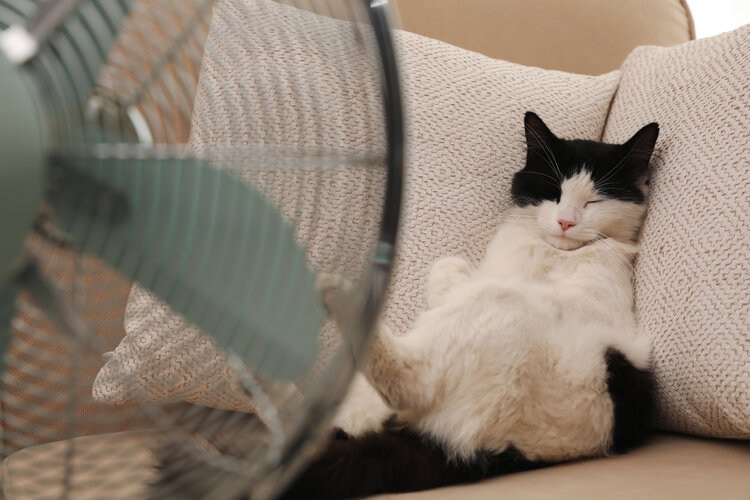
If you recently adopted a feline or are just looking for fun information about your pet, you might wonder what the best temperature is to keep your companion healthy and happy. Cats, it turns out, are amazingly adaptable creatures that do well in hot, temperate, and cold climates.
They’re generally most comfortable at indoor temperatures between 68°F and 77°F. For most healthy cats, outdoor temperatures between 45°F and 100°F are perfectly acceptable. Essentially, if you’re comfortable, chances are your cat is too. Below, we address your most pressing questions about cats, cold, heat, and humidity.
How Do I Know if It’s Too Hot for My Cat?
Cats typically have temperatures that fall between 99.5° and 102.5°F, only slightly higher than the normal range in humans. Cats begin to suffer from heat exposure when environmental conditions cause their temperatures to rise outside the normal range. As a general rule, when the mercury rises above 100°F, cats should stay inside.
And don’t forget to pay attention to the humidity! When it’s humid, your cat will be safer inside even if the temperature is below 100°F. To be safe, let your cat roam outdoors during cooler periods of the day or walk them on a leash so you can quickly move indoors if you start seeing signs of heat exhaustion.
Cats whose body temperatures have risen to uncomfortable but not dangerous levels often attempt to cool off by panting, sweating through their paws, drinking water, trying to find shade and grooming. Cats in the beginning stages of clinical heat stress will display labored breathing and have difficulty with coordination. If left untreated, heat stress causes unconsciousness and even death.
If your cat is just starting to exhibit indications they’re too hot, bring them to a cool location, give them access to cool (not cold) water, and encourage them to drink. You can also moisten your cat’s fur to provide some relief from the heat, although you may pay the price later since most cats dislike human-initiated activities involving water.
If your cat is suffering from extreme heat stroke and is no longer responsive, wet their fur, start cooling them down, soaking them with cool water, then cover an ice pack with a towel and place it between their legs. Contact your veterinarian immediately.

How Do I Know if It’s Too Cold for My Cat?
If you feel cold while sitting around watching TV or reading a book, there’s a good chance your feline friend might be a bit on the chilly side as well. Most veterinarians recommend keeping cats inside when the temperature drops below 45°F. Be extra alert in snowy conditions since cats can contract hypothermia when their fur gets wet. If it’s 32°F or lower outside, your furry companion should probably take a day off from any outdoor adventures.
Cats that need to warm up can have cold ears and paws, and they also tend to gravitate towards sources of warmth. Kitties exposed to extremely low temperatures for extended periods can get hypothermia. At the beginning stages of hypothermia, cats display symptoms such as shivering and a general lack of alertness.
The best way to keep your cat from becoming too cold is to ensure they stay indoors on cold days. If, despite your best efforts, your feline friend ends up a bit on the chilly side, there’s plenty you can do to help.
Snuggle them in a warm blanket and make sure they’re cozy and dry. Fill a hot water bottle, wrap it in a towel, and place it near your buddy to give it a way to get warm. Contact your vet if your cat doesn’t perk up and become active.
What About Maine Coon Oats and Other Long-Haired Breeds
Maine Coon cats and other long-haired breeds are known for enjoying cold weather, but they’re generally fine in warmer climates as well. Healthy adult Maine Coon cats are okay with indoor temperatures as low as 60°F. Outdoor temperatures as low as 30°F don’t seem to phase these long-haired beauties—as long they stay on the move!
Long-haired breeds who go outdoors on hot days need to be closely monitored when the temperature flirts with 90°F as they tend to become overheated faster than their short-haired relatives. Cooling mats are a great option if you’re looking for an environmentally friendly way to keep your feline companion comfortable in the heat.

What About Sphynx and Other Bald Cats?
Sphynx cats require extra tender loving care in the temperature department! Because these sweet, loving cats don’t have fur (or much of it, depending on the animal), you’ll need to work harder to keep them warm when it’s cold outside. Hairless kitties tend to be happiest with indoor temperatures above 70°F.
These elegant felines don’t typically enjoy the lower temperatures Maine Coon cats and other long-haired breeds relish. If you’re cold, your hairless cat is probably utterly freezing. To keep your Sphynx buddy warm, give it plenty of warm blankets and have a self-heating cat bed at its disposal.
What About Elderly Cats?
Just like humans, elderly cats and those suffering from limited mobility often enjoy a bit of extra warmth. Still, you don’t need to turn up the thermostat to keep your furry companion comfy. Consider investing in a self-warming cat bed to provide your older buddy with a cozy place to doze in total comfort, and make sure to put it somewhere accessible for your cat to reach without jumping.

Conclusion
Adjusting the temperature to keep your cat comfortable should not be an issue since the feline’s internal temperature is only a few degrees higher than a human’s. However, cats should always be dried off quickly when they get wet because cold, damp fur will cause their temperature to drop. Unless you have a cold-weather breed, your cat is safer indoors during colder weather.
See also:
Featured Image Credit: New Africa, Shutterstock






